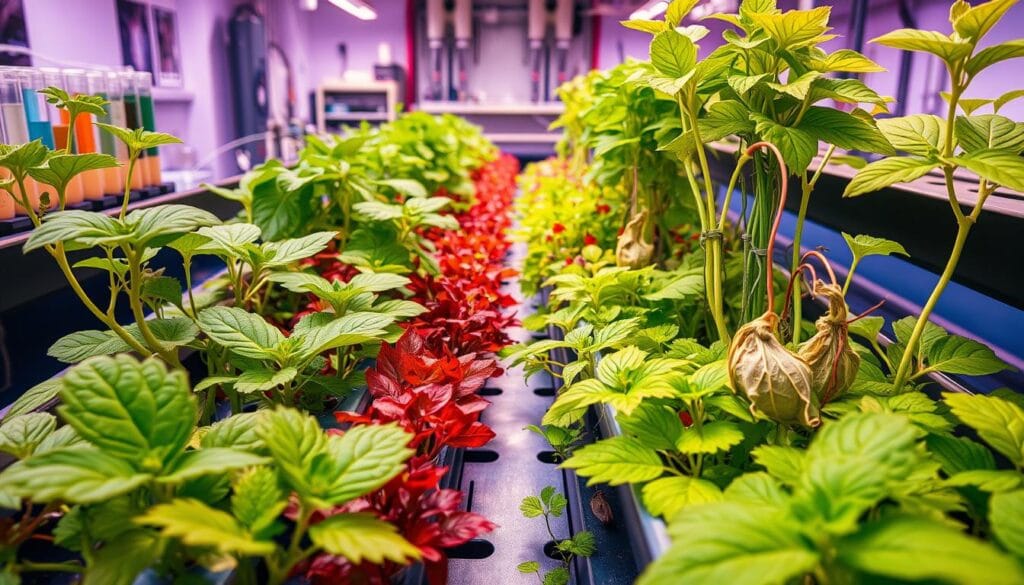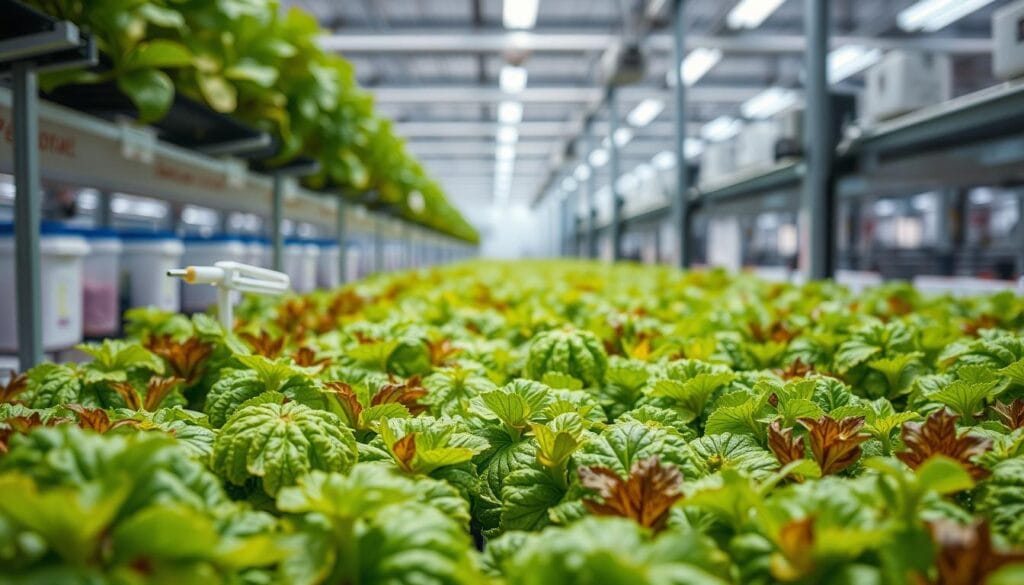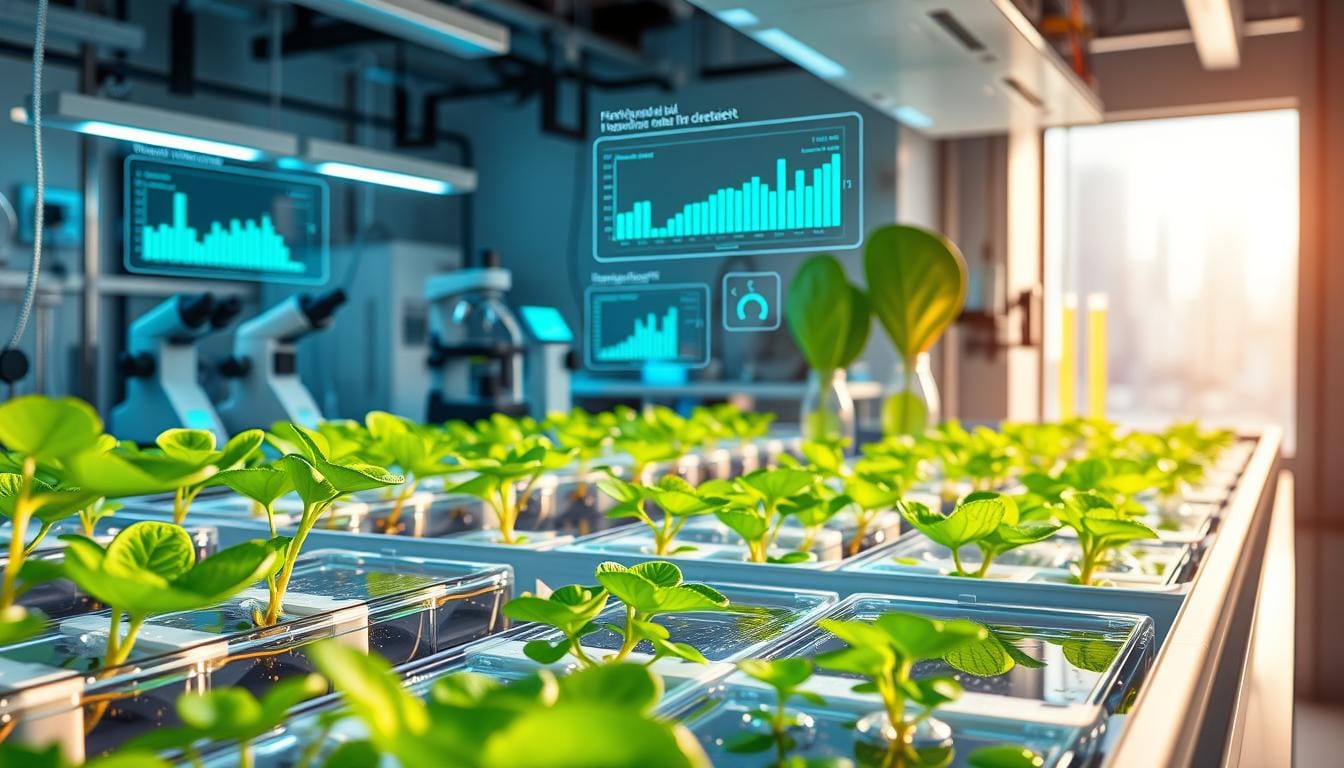The Impact of Heavy Metals on Hydroponics: Have you ever thought about the hidden world of heavy metals and their effect on plant growth? As urban farming and hydroponic systems transform food production, understanding their presence and impact is crucial for growing safe, healthy plants.
Recent studies show how heavy metals, hydroponics, and plant nutrition work together. With 770 research articles showing its importance, we’re exploring the complex world of water quality and plant health.
Hydroponics can help control heavy metals. But, it’s key to manage nutrients carefully to avoid toxic buildup. This ensures your crops are safe and healthy.
Key Takeaways
- Heavy metals can significantly impact plant growth and nutrient absorption
- Hydroponic systems provide better control over environmental factors
- Proper water quality management is essential for crop safety
- Zinc supplementation can help counteract cadmium toxicity
- Regular monitoring of nutrient solutions prevents heavy metal buildup
Understanding Heavy Metals: Essential vs. Non-Essential Elements
Heavy metals are key for plant growth and keeping our environment healthy. Knowing about these elements helps manage hydroponic systems and grow plants well.
There are two main types of heavy metals: essential and non-essential. Each type affects plant health and growth differently.
Essential Heavy Metals for Plant Growth
Essential heavy metals are needed for plants to grow and work properly. They help with important biological tasks when present in the right amounts.
- Zinc (Zn): Supports enzyme activation and protein structure
- Copper (Cu): Facilitates photosynthesis and enzyme processes
- Iron (Fe): Critical for chlorophyll production
- Cobalt (Co): Assists in nitrogen metabolism
“Long-term evolution has enabled plants to develop mechanisms to resist external stress from heavy metals.” – Plant Research Institute.
Non-Essential Heavy Metals and Their Toxicity
Non-essential heavy metals can harm plants, even in small amounts. They can mess with cell functions and slow down growth.
| Non-Essential Heavy Metal | Toxicity Impact |
|---|---|
| Cadmium (Cd) | 26.11% decrease in plant yield |
| Lead (Pb) | Disrupts photosynthetic processes |
| Mercury (Hg) | Severe cellular damage |
Common Sources of Heavy Metal Contamination
Knowing where heavy metals come from helps keep hydroponic systems safe. Industrial waste, mining, and natural events can bring them into our systems.
- Industrial waste discharge
- Mining activities
- Agricultural fertilizers
- Volcanic eruptions
- Soil erosion
It’s important to watch and manage heavy metals to keep hydroponic systems healthy.
The Impact of Heavy Metals on Hydroponics: A Comprehensive Overview
Hydroponic contamination is a big problem in farming today. Knowing about toxic metal uptake can help keep plants healthy and manage nutrients better. Recent studies have shown interesting facts about heavy metals in hydroponics.
“The productivity of your hydroponic system is strongly influenced by the quality of the nutrient solution applied.” – Agricultural Research Institute
Important findings show how heavy metals affect hydroponics:
- Lead and cadmium levels are much lower in hydroponic veggies.
- Hydroponic veggies have 84% fewer pesticides than regular farming.
- Just 30% of hydroponic veggies have pesticide residues.
The risk of health problems from hydroponic veggies is much lower (0.22) than from regular veggies (0.64). This means hydroponics can reduce health risks by managing metals well.
Things that affect metal contamination include:
- Water quality
- Nutrient solution mix
- Keeping the irrigation system clean
- Checking metal levels often
By using strict testing and knowing where contamination can come from, you can make your hydroponics safer and more effective.
Comparing Heavy Metal Presence in Traditional and Hydroponic Agriculture
Soil agriculture and hydroponic systems have big differences. These differences affect how much heavy metals get into our food. Knowing this helps us choose safer food.
Soil vs. Hydroponic Growing Systems
Hydroponic systems are better at keeping heavy metals out. Soil farming has a harder time stopping contamination.
- Hydroponic systems provide more precise nutrient management
- Controlled environments reduce external contamination risks
- Water-based growing methods allow for better monitoring
Contamination Rates and Risk Factors
Studies show big differences in heavy metals between soil and hydroponic farming. Hydroponic farming looks promising.
| Contaminant | Soil Agriculture | Hydroponic Systems |
|---|---|---|
| Lead Concentration | 16x Higher | Significantly Lower |
| Cadmium Levels | 8.6x Higher | Minimal Detection |
Environmental Impact Assessment
Hydroponic farming is better for the environment. It uses less water and fewer chemicals. Choosing hydroponic food helps the planet.
“Hydroponic farming represents a promising solution for reducing agricultural environmental footprints.” – Agricultural Innovation Research Center.
Understanding these differences helps us make better food choices. We can support sustainable farming by choosing hydroponic food.
The Science Behind Heavy Metal Uptake in Hydroponic Systems
Learning about metal absorption in hydroponics needs a deep look into how plants work and how they take in nutrients. Scientists have found amazing ways plants deal with heavy metals. They’ve uncovered complex biological steps that control how plants absorb and move these metals.
Research on hydroponics has shown us a lot about how plants interact with metals:
- There are about 700 different hyperaccumulator plant species worldwide
- Seventy percent of these plants excel at absorbing nickel efficiently
- Each plant species has its way of taking in metals
“Plants actively interact with their environment; they don’t simply sit passively, waiting for metals to come to them. They are part of their chemical world.”
How plants take in nutrients varies a lot. Some plants can hold huge amounts of metals. For instance, Noccaea caerulescens can accumulate over 20,000 µg g⁻¹ of zinc, even when growing in soil with low zinc content.
The hydroponic setup lets scientists control the environment to study metal absorption. They can change:
- How much metal is present
- The pH levels
- The mix of nutrients in the solution
By understanding these complex metal absorption processes, you can find ways to handle and reduce heavy metal pollution in hydroponic systems.
Critical Heavy Metal Concentration Levels in Hydroponic Solutions
It’s important to know about heavy metals in hydroponic systems. This knowledge helps keep plants healthy and food safe. Your hydroponic garden needs regular checks to avoid contamination and get the best crops.
Safe Threshold Limits for Metal Detection
Setting the right limits for heavy metals is key in hydroponics. Each metal has its safe range. These ranges affect plant growth and our health.
- Zinc: 0.1-5 mg/L
- Cadmium: Less than 0.005 mg/L
- Lead: Maximum 0.01 mg/L
- Copper: 0.2-0.5 mg/L
Advanced Detection and Monitoring Techniques
Today, we use advanced tech to keep hydroponic solutions safe. This tech helps find and prevent contamination.
- X-ray Fluorescence Analysis
- Inductively Coupled Plasma Mass Spectrometry
- Atomic Absorption Spectroscopy
Comprehensive Prevention Strategies
“Proactive monitoring is the key to maintaining a healthy hydroponic environment.”
To lower heavy metal risks, use strong prevention steps. Test water regularly, use advanced filters, and manage nutrient solutions carefully. These actions are vital.
| Prevention Method | Effectiveness |
|---|---|
| Reverse Osmosis Filtration | 95% Heavy Metal Removal |
| Activated Carbon Filters | 80% Contaminant Reduction |
| Periodic Water Testing | Continuous Monitoring |
By understanding and using these strategies, you can make your hydroponic space safe and productive. This way, you reduce heavy metal risks and improve plant health.
Influence of Heavy Metals on Plant Growth and Physiological Processes

Heavy metals pose big challenges for plant health. They can mess up your hydroponic systems. Knowing how they harm plants helps growers keep their crops safe.
The ways heavy metals hurt plants are many:
- Reduced biomass accumulation
- Chlorosis and leaf discoloration
- Inhibition of photosynthetic processes
- Disrupted water and nutrient absorption
- Impaired enzymatic activities
Heavy metals mess with plant cells in complex ways. Even good metals like zinc and copper can be bad in too much. They can overwhelm a plant’s defenses.
“Plants have evolved remarkable strategies to manage and mitigate heavy metal stress, demonstrating nature’s incredible adaptability.” – Agricultural Stress Research Institute.
Some plants, called hyperaccumulators, can handle a lot of heavy metals. They might even store these metals. This makes them useful for cleaning up polluted areas.
| Heavy Metal | Impact Level | Plant Response |
|---|---|---|
| Cadmium | High Toxicity | Severe Growth Reduction |
| Lead | Moderate Toxicity | Photosynthetic Disruption |
| Copper | Low to Moderate | Enzymatic Interference |
By grasping these complex issues, hydroponic farmers can fight heavy metal harm. They can keep their plants healthy and thriving.
Water Quality Management and Heavy Metal Prevention
To keep your hydroponic system safe from heavy metals, you need a solid water quality plan. Clean water is key for your plants to grow well and stay healthy.
- Use advanced filtration methods
- Test your water regularly
- Keep your system in top shape
Filtration Systems and Technologies
There are many ways to purify water for hydroponics. Each method targets different pollutants to keep your water clean.
| Filtration Type | Efficiency Rate | Key Benefits |
|---|---|---|
| Sediment Filters | 85-90% | Removes particles and debris |
| Carbon Filters | 90-95% | Eliminates chlorine and organic compounds |
| Reverse Osmosis | 95-99% | Removes heavy metals and dissolved solids |
Regular Maintenance Protocols
Regular upkeep is vital to stop heavy metals from building up. Your hydroponic system needs regular checks to work its best.
Proactive maintenance is the key to long-term success in hydroponic cultivation.
Here are some maintenance tips:
- Test your water every 2-3 days
- Check pH levels between 5.8-6.3
- Keep water at 65-75°F
- Flush tubes and pipes often
Remember, it’s cheaper to prevent contamination than to fix it later. Good water purification and filtration keep your crops healthy and your yields high.
Bioaccumulation and Food Safety Concerns

Heavy metals in hydroponic crops are a big problem for food safety. It’s important to know how these toxins get into our food. Understanding metal accumulation can help mitigate health risks associated with consuming hydroponic produce.
“The unseen risk of heavy metals in our food system demands careful monitoring and proactive action.” – Environmental Health Research Institute
Each plant type builds up metals differently, making it hard to track contamination. Studies show how metals spread in plants:
- Copper and zinc mainly build up in stems
- Cadmium mostly goes to roots and stems
- Lead mostly stays in the roots
When metals like cadmium and arsenic move from plants to people, it’s a big danger. Long-term exposure can lead to:
- Neurological problems
- Kidney damage
- Possible cancer risks
| Metal | Accumulation Zone | Health Risk Level |
|---|---|---|
| Cadmium | Roots, Stems | High |
| Lead | Roots | Moderate to High |
| Arsenic | Roots, Lower Stems | High |
Hydroponic farmers need to check their crops closely to avoid metal buildup. Testing regularly and managing nutrients well are key to keeping your food safe. This helps protect people from heavy metal dangers.
Environmental Factors Affecting Heavy Metal Absorption
It’s important to understand how the environment affects heavy metal absorption in hydroponics. Managing these factors well can greatly improve plant health and crop quality.
pH Influence on Metal Solubility
pH levels are key in hydroponics. They change how metals dissolve and become available to plants. This can make metals more or less accessible to roots.
- Lower pH levels increase metal solubility
- Optimal pH range typically between 5.5 and 6.5
- Extreme pH can trigger metal toxicity
Temperature Impact on Metal Uptake
Temperature affects how fast plants absorb metals. It also changes how plants process nutrients. This is important in hydroponic systems.
| Temperature Range | Metal Absorption Effect |
|---|---|
| 15-20°C | Reduced metal uptake |
| 20-25°C | Optimal absorption |
| 25-30°C | Increased metabolic stress |
Nutrient Competition Dynamics
Nutrients in hydroponics compete with each other. Some nutrients can help or hinder metal absorption. This depends on their chemical interactions.
“Effective nutrient management is key to minimizing heavy metal toxicity in hydroponic systems.” – Hydroponic Research Institute.
By watching and adjusting these factors, you can make your hydroponic system better. This helps reduce heavy metal risks.
Solutions and Best Practices for Heavy Metal Management
Managing heavy metals in hydroponics needs a careful plan. It combines stopping problems before they start and fixing them when they do. Protecting your crops relies on implementing the proper measures to prevent contamination.
“Taking a proactive approach is vital to ensuring hydroponic systems remain both healthy and efficient.” – Agricultural Research Institute
Good ways to fix problems include:
- Regular water quality testing
- Advanced filtration systems
- Nutrient solution management
- Phytoremediation techniques
Preventing issues before they arise is equally crucial. Using Reverse Osmosis filtration is a great way to do this. It can remove 95-99% of dissolved solids and heavy metals. Other methods include:
| Filtration Method | Efficiency Rate | Contaminants Removed |
|---|---|---|
| Sediment Filters | 85-90% | Particles and Debris |
| Carbon Filters | 90-95% | Chlorine and Organic Compounds |
| Reverse Osmosis | 95-99% | Heavy Metals and Dissolved Solids |
Using silicon nanoparticles is another smart move. They can lower the levels of harmful metals in plants. This helps protect your crops even more.
To make these solutions work, you need to keep checking things and be ready to act. By focusing on stopping problems early and using the latest fixing methods, you can keep your hydroponic system safe and healthy.
Conclusion
Exploring hydroponic cultivation opens up new paths for sustainable agriculture. The data shows hydroponics have a big safety advantage. Pesticide use drops from 84% in traditional farming to 30% in hydroponics.
This big drop shows how new growing methods cut down on contamination risks. It plays a key role in making farming safer.
Research keeps pushing hydroponic tech forward. The global hydroponic market is expected to grow by 18.8%. This shows more people trust these new farming ways.
By using strict water tests and new filters, you can control heavy metals. This ensures your crops stay safe and healthy.
Success in hydroponics comes from always watching and adjusting. New methods like silicon nanoparticles could help even more. These systems are a big step forward in green farming.
Your effort to learn and use the best methods is key. It helps move these new farming ideas forward.
Researchers like Liam Reynolds and Vitória Leme are finding new ways. The future of hydroponic farming looks very promising. By keeping up with the latest, you help make farming safer and greener.

